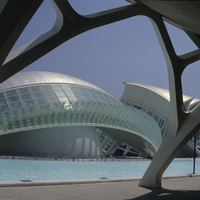City of Arts and Sciences
Item
- Title
- Alternative Title
- Creator
- City
- Country
- Date Created
- Century
- Classification
- Style/Period
- Cultural Context
- Materials
- Techniques
- Subject
- Description
- Source
- Photographer
- Rights Holder
- Access Rights
-
City of Arts and Sciences
-
Ciudad de las Artes y las Ciencias
-
Felix Candela (Mexican architect, 1910-1998)
-
Santiago Calatrava Valls (Spanish architect, born 1951)
-
Valencia, Valencia, Spain
-
Spain
-
1991-2005 (creation)
-
20th century
-
21st century
-
Architecture and City Planning
-
Twenty-first century
-
Spanish
-
glass
-
steel
-
ceramic tile
-
construction (assembling)
-
gardening
-
architecture
-
contemporary (1960 to present)
-
recreation and games
-
festivals
-
seascape
-
parks (recreation areas)
-
View from L'Umbracle on the southern façade of the complex in the Promenade and Car Park, showing the planetarium and Science Museum, The City of Arts and Sciences is an entertainment-based cultural and architectural complex. It is the most important modern tourist destination in the city of Valencia. It is situated at the end of the old riverbed Turia. Turia became a garden in 1980, after the bypass of the river by the great flood of Valencia in 1957. Designed by Santiago Calatrava and Felix Candela, the project underwent the first stages of construction in July, 1996 and the finished city was inaugurated April 16, 1998 with the opening of L'Hemisferic. The last great component of the City of the Arts and the Sciences, El Palau de les Arts Reina Sofia, was opened October 9, 2005.
-
Javier Gomez
-
Javier Gomez
-
© Javier Gomez
-
Texas Tech University Libraries
-
Users must request permission from the copyright holder for all use in publications, including theses and dissertations.
Felix Candela (Mexican architect, 1910-1998) and Santiago Calatrava Valls (Spanish architect, born 1951), “City of Arts and Sciences”, Arch Design Images, accessed August 11, 2025, https://exhibits.lib.ttu.edu/s/archlib/item/34366


